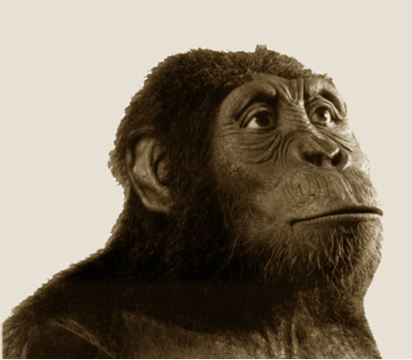Australopithecus anamensis
- Kanapoi and Allia Bay ( Lake Turkana, Kenya)
Australopithecus anamensis is a species of the extinct genus Australopithecus. Fossils that have been associated with this type come from around 4 million year old layers Fund East Africa.
Australopithecus anamensis is considered the oldest type of australopithecines and at the same time as the oldest undisputed nature of Hominini. As very probably true also that Australopithecus anamensis and Australopithecus afarensis younger chronologically successive sister - species due anagenesis are.
Naming
The name of the genus Australopithecus is derived from the Latin australis ( " southern " ) and Greek πίθηκος, AltGr. pronounced píthēkos ( "Monkey "). The epithet anam mean in Turkana language "lake" and refers to the site on the Lake Turkana; Australopithecus anamensis therefore means " southern ape from the lake ."
Fund position
From Australopithecus anamensis are today some 50 discoveries, which mainly include jaw and limb bones and some teeth:
Since 2006, several excavations in the Afar Triangle ( Ethiopia) were discovered many more fragments of this species and associated with at least eight individuals in the course, including the largest known canine and the oldest thigh - bone of a Australopithecus. Associated finds that 4.2 to 4.1 million years old, found objects speak in this region for a habitat of forests and savannas, ie for so-called gallery forests; there are no fossils have been found, suggesting open water.
The Fundsituaton to A. anamensis arises insofar quite comprehensive, and includes a 50 part fossils whose age is sometimes difficult to determine, but can be close to a total period of 4.2 to 3.9 million years ago.
Evaluation of the findings
Australopithecus anamensis differs markedly from the older Ardipithecus ramidus, but also - especially regarding the construction of the teeth - the younger Australopithecus afarensis. His skull resembles that of the chimpanzee, the rows of teeth in the lower jaw and upper jaw are almost parallel to each other. Its large canine teeth are oblique to the occlusal surface, and the back teeth are quite large, which suggests the consumption of relatively coarse vegetable food. 2013 yielded an isotopic analysis of teeth of finds from the Turkana Basin, Australopithecus anamensis that a high proportion of relatively soft C3 plants consumed while Australopithecus afarensis primarily C4 plants consumed.
The paleoanthropologist Friedemann Schrenk describes the appearance as follows:
Similar to the much older Sahelanthropus tchadensis associated finds were the first individuals discovered at Lake Turkana (including fossil antelopes, especially from Kudus ) suggest that Australopithecus anamensis lived in a habitat that consisted partly of bushland, partly from Savannah.
The findings from the Afar region have been interpreted to the effect that researchers working with Tim White, Australopithecus anamensis that stand in relation to many anatomical features between Ardipithecus ramidus and Australopithecus afarensis. The relatively large teeth were also interpreted these findings as an adaptation to relatively hard plant food, as was to be expected from a domestic at least on the edge of a steppe landscape type.









.JPG/220px-Australopithecus_anamensis_bone_(University_of_Zurich).JPG)
